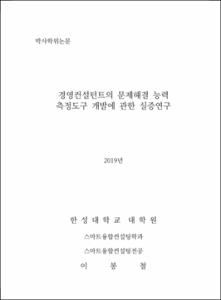경영컨설턴트의 문제해결 능력 측정도구 개발에 관한 실증연구
= An Empirical Study on the Scale Development of the Problem-solving Test for Management Consultants
- Appears in Collections:
- 스마트융합컨설팅학과 > 1. Thesis
- Files in This Item:
-
-
Download
 200000215747.pdf
기타 데이터 / 5.91 MB / Adobe PDF
200000215747.pdf
기타 데이터 / 5.91 MB / Adobe PDF
-
Items in Repository are protected by copyright, with all rights reserved, unless otherwise indicated.